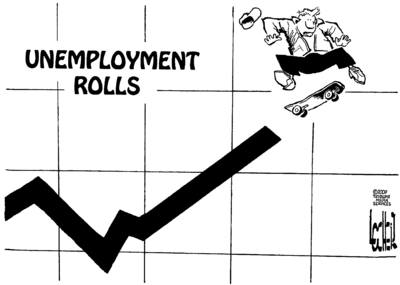- MENU
- HOME
- SEARCH
- VIDEOS
- WORLD
- MAIN
- AFRICA
- ASIA
- BALKANS
- EUROPE
- LATIN AMERICA
- MIDDLE EAST
- United Kingdom
- United States
- Argentina
- Australia
- Austria
- Benelux
- Brazil
- Canada
- China
- France
- Germany
- Greece
- Hungary
- India
- Indonesia
- Ireland
- Israel
- Italy
- Japan
- Korea
- Mexico
- New Zealand
- Pakistan
- Philippines
- Poland
- Russia
- South Africa
- Spain
- Taiwan
- Turkey
- USA
- BUSINESS
- WEALTH
- STOCKS
- TECH
- HEALTH
- LIFESTYLE
- ENTERTAINMENT
- SPORTS
- RSS
- iHaveNet.com: Economy
by Liz Wolgemuth

In what will no doubt boost skepticism over the Obama administration's message of stimulus success, the unemployment rate in October rocketed to 10.2 percent, a figure much higher than economists had expected and just 0.6 percentage points away from the post-World War II high seen in 1982. While unemployment snapped back down swiftly in the early-1980s recession, it is widely expected that job creation will be slow in this recovery.
Employers cut 190,000 jobs from their payrolls last month, the
The very bad news: Job losses continued to be centered in construction and manufacturing. These two industries have been absolutely hammered by this recession. Construction employment has now fallen by 1.6 million since December 2007, the first month of the recession. Manufacturing employment has fallen by 2.1 million over the same period.
The two industries also employ a disproportionately high percentage of men. The unemployment rate in October for adult men reached 10.7 percent, compared with 8.1 percent for women.
The steep increase in the unemployment rate, which is measured separately from payroll employment, reflected the fact that few workers dropped out of the workforce in October. Typically, well into a long recession, many workers stop looking for work and are no longer counted among the unemployed, which prevents a massive uptick in the unemployment rate. Similarly, if more workers were entering the workforce to look for jobs, it would have pushed the rate even higher. However, the participation rate changed little in October.
The very good news (yes, there is some): Perhaps most promising is the addition of 34,000 jobs in temporary services. From the start of the recession through July of this year, temporary services lost an average of 44,000 jobs monthly. Temp jobs can serve as a useful leading indicator for overall employment: As employers see demand increase, they may test the waters by bringing on temporary help before committing to permanent hires. Tig Gilliam, chief executive of staffing giant
The healthcare industry added 29,000 jobs in October, bringing total healthcare industry job gains throughout the recession to nearly 600,000. Also a bright spot: Average hourly earnings jumped by 5 cents, or 0.3 percent. That's "a surprisingly large gain &ellips; which should help to support income," report economists David Greenlaw and Ted Wieseman of
In a morning note, Christina Romer, chair of the President's
What happens next: Despite signs of improvement--as in temp jobs and hourly earnings--the steep rise in the unemployment rate does spell trouble for hopes of a near-term jobs recovery. "Our forecast has been for the unemployment rate to peak at about 10.5 percent in mid-2010," says Joshua Shapiro, chief U.S. economist at MFR. "This now looks too conservative."
Congress yesterday cleared a bill providing another federally funded unemployment benefits extension of 14 to 20 additional weeks for eligible workers. It was sent to the president's desk just in time for the dreary jobs report. President Obama signed the bill 2 ½ hours after the report was released. With much of the stimulus money still being spent and the majority of the jobs in energy and construction yet to be created, the president has resisted the idea of another stimulus bill. The administration does appear to be open to such tools as creating a tax credit for companies that make new hires.
© U.S. News & World Report
WORLD | AFRICA | ASIA | EUROPE | LATIN AMERICA | MIDDLE EAST | UNITED STATES | ECONOMY | EDUCATION | ENVIRONMENT | FOREIGN POLICY | POLITICS
Economy: October Jobs Report: A True Witches' Brew - Liz Wolgemuth